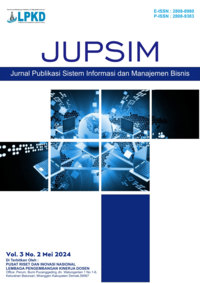Pengaruh Disiplin terhadap Kinerja Pegawai pada Bagian Protokol dan Komunikasi Pimpinan Sekretariat Daerah Kabupaten Paser
DOI:
https://doi.org/10.55606/jupsim.v4i2.4532Kata Kunci:
Discipline, Employee Performance, PerformanceAbstrak
The purpose of this study was to determine the effect of discipline on employee performance in the protocol and communication section of the Paser Regency Regional Secretariat. The research method used in this study is a quantitative method. The population in this study were all employees working in the Protocol and Communication Section of the Paser Regency Regional Secretariat, totaling 34 people. In this study, the researcher used a total sample technique so that the sample in this study was 34 employees. The data analysis technique used was multiple linear regression analysis with the help of SPSS Version 26. The results of the study showed that the variables Preventive Discipline, Corrective Discipline, and Progressive Discipline had a positive effect on Employee Performance in the Protocol and Communication Section of the Paser Regency Regional Secretariat. Simultaneous testing of the F count value of 6.236 with a significance level of 0.002, it is known that the F table value is 2.92 (df 3:30) then 6.236> 2.92 means that together the discipline variables consisting of Preventive Discipline (X1), Corrective Discipline (X2), Progressive Discipline (X3), have an effect on Employee Performance (Y). From the results of the determination coefficient (R2) the Adjusted R Square value is 0.332 or 33.2% meaning that the independent variable, namely discipline (X) consisting of Preventive Discipline (X1), Corrective Discipline (X2), Progressive Discipline (X3), contributes 33.2% to Employee Performance, the remaining 56.8% is distributed by other variables not examined in this study.
Referensi
Ajabar. (2020). Manajemen sumber daya manusia (Cet. 1). CV Budi Utama.
Athoillah, A. (2017). Dasar-dasar manajemen (Cet. 3). Pustaka Setia.
Gato, P. A., & Awangga, R. M. (2023). Pengelompokan kedisiplinan pegawai berdasarkan absensi menggunakan algoritma K-Means. Buku Pedia.
Hamali, A. Y. (2018). Pemahaman manajemen sumber daya manusia (Cet. 2). CAPS (Center for Academic Publishing Service).
Mangkunegara, A. P. (2017). Manajemen sumber daya manusia. PT Remaja Rosdakarya.
Parera, A. (2020). Dasar-dasar manajemen. Bumi Aksara.
Priyatno, D. (2010). Statistik data penelitian. MediaKom.
Rahim, A. R. (2020). Cara praktis penulisan karya ilmiah (Cet. 1). Zagir Publishing.
Sinambela, L. P. (2016). Manajemen sumber daya manusia (Cet. 1). Bumi Aksara.
Sugiyono. (2019). Metode penelitian kuantitatif, kualitatif, dan R&D. Alfabeta.
Sujarweni, W. (2022). Metodologi penelitian bisnis ekonomi. Pustaka Baru Press.
Sunatar, B. (2022). Meningkatkan motivasi dan kinerja dosen pada perguruan tinggi (Cet. 1). CV Feniks Muda Sejahtera.
Surajiyo, Nasruddin, & Paleni, H. (2020). Penelitian sumber daya manusia (Cet. 1). CV Budi Utama.
Tiong, P. (2023). Manajemen sumber daya manusia. CV Budi Utama.
Unduhan
Diterbitkan
Cara Mengutip
Terbitan
Bagian
Lisensi
Hak Cipta (c) 2025 Jurnal Publikasi Sistem Informasi dan Manajemen Bisnis

Artikel ini berlisensiCreative Commons Attribution-ShareAlike 4.0 International License.







